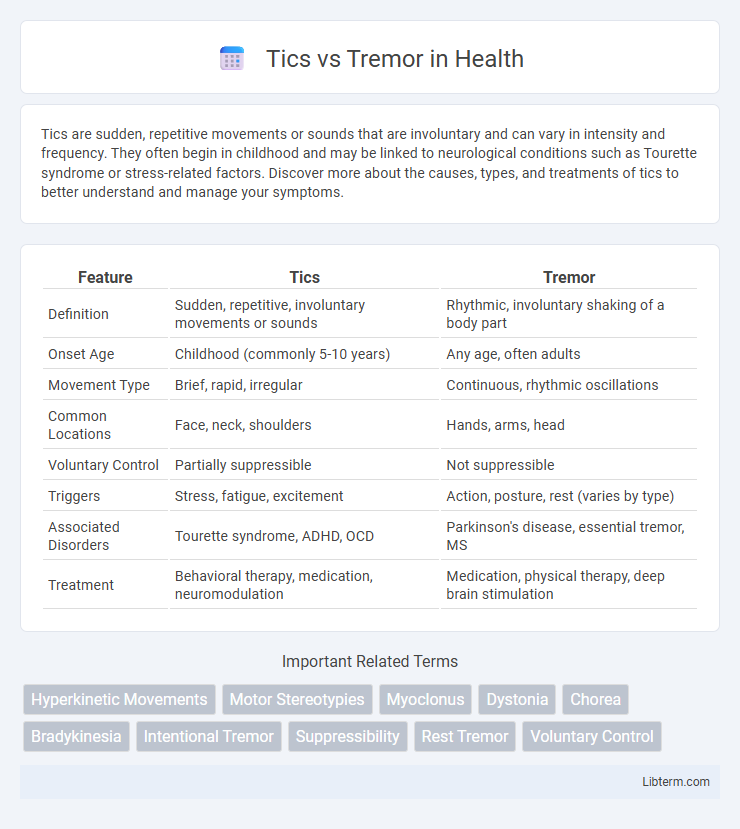Tics are sudden, repetitive movements or sounds that are involuntary and can vary in intensity and frequency. They often begin in childhood and may be linked to neurological conditions such as Tourette syndrome or stress-related factors. Discover more about the causes, types, and treatments of tics to better understand and manage your symptoms.
Table of Comparison
| Feature | Tics | Tremor |
|---|---|---|
| Definition | Sudden, repetitive, involuntary movements or sounds | Rhythmic, involuntary shaking of a body part |
| Onset Age | Childhood (commonly 5-10 years) | Any age, often adults |
| Movement Type | Brief, rapid, irregular | Continuous, rhythmic oscillations |
| Common Locations | Face, neck, shoulders | Hands, arms, head |
| Voluntary Control | Partially suppressible | Not suppressible |
| Triggers | Stress, fatigue, excitement | Action, posture, rest (varies by type) |
| Associated Disorders | Tourette syndrome, ADHD, OCD | Parkinson's disease, essential tremor, MS |
| Treatment | Behavioral therapy, medication, neuromodulation | Medication, physical therapy, deep brain stimulation |
Understanding Tics and Tremors
Tics are sudden, repetitive, non-rhythmic movements or vocalizations often linked to neurological conditions like Tourette syndrome, whereas tremors are involuntary, rhythmic muscle contractions causing shaking typically associated with Parkinson's disease or essential tremor. Differentiating tics from tremors involves evaluating patterns, triggers, and suppressibility; tics may decrease with focused attention or behavioral therapy, while tremors usually persist and worsen with movement. Accurate diagnosis is crucial for effective treatment, as tics respond better to behavioral interventions and certain medications, while tremors may require pharmacologic therapy or deep brain stimulation.
Key Differences Between Tics and Tremors
Tics are sudden, repetitive, non-rhythmic movements or sounds often preceded by an urge and temporarily suppressible, whereas tremors are rhythmic, involuntary shaking motions typically caused by neurological or physiological conditions. Tics usually emerge in childhood and are associated with disorders like Tourette syndrome, while tremors commonly appear later in life and are linked to diseases such as Parkinson's or essential tremor. The frequency and pattern of movements distinguish them: tics can be complex or simple with variable occurrence, while tremors exhibit consistent rhythmic oscillations.
Types of Tics: Motor and Vocal
Motor tics are sudden, repetitive movements such as eye blinking, facial grimacing, or shoulder shrugging, while vocal tics involve involuntary sounds like throat clearing, grunting, or repeating words. Both types of tics can be transient or chronic, often observed in conditions like Tourette Syndrome and chronic tic disorder. Understanding the distinction between motor and vocal tics is crucial for accurate diagnosis and effective management strategies.
Types of Tremors: Resting and Action
Resting tremors occur when muscles are relaxed, commonly seen in Parkinson's disease, characterized by rhythmic shaking in parts like the hands or fingers. Action tremors manifest during voluntary muscle movement, encompassing subtypes such as kinetic, postural, and intention tremors, affecting tasks like writing or maintaining a posture. Differentiating tics, which are sudden, repetitive, non-rhythmic movements, from tremors is critical for accurate diagnosis and treatment planning.
Causes of Tics
Tics are sudden, repetitive, nonrhythmic movements or vocalizations often triggered by genetic and neurodevelopmental factors, whereas tremors are rhythmic, involuntary muscle contractions typically caused by neurological disorders. The primary causes of tics include family history, neurochemical imbalances involving dopamine and serotonin, and environmental stressors that exacerbate symptoms. Understanding these underlying causes is crucial for distinguishing tics from tremors and guiding appropriate treatment strategies.
Causes of Tremors
Tremors are primarily caused by neurological disorders such as Parkinson's disease, multiple sclerosis, or essential tremor, often linked to abnormalities in brain areas controlling movement like the cerebellum or basal ganglia. Other causes include medications, stress, fatigue, and metabolic imbalances such as hyperthyroidism. Unlike tics, which are sudden, repetitive movements often associated with neuropsychiatric conditions like Tourette syndrome, tremors involve rhythmic, involuntary shaking that worsens with specific actions or at rest.
Symptoms and How They Present
Tics manifest as sudden, repetitive, non-rhythmic movements or vocalizations, often preceded by an urge and can be temporarily suppressed, commonly seen in conditions like Tourette syndrome. Tremors present as involuntary, rhythmic shaking typically affecting the hands, head, or voice, and worsen during movement or when maintaining posture, characteristic of disorders such as Parkinson's disease. Unlike tics, tremors lack the premonitory sensation and are consistent in frequency and amplitude, reflecting different underlying neurological mechanisms.
Diagnosis: Distinguishing Tics from Tremors
Tics are characterized by sudden, repetitive, nonrhythmic movements or vocalizations often preceded by an urge, while tremors involve rhythmic, involuntary oscillatory movements. Diagnosis relies on clinical observation, with tics typically showing suppressibility and variability in frequency, opposed to the persistent, regular pattern of tremors. Electromyography (EMG) and neuroimaging can assist in differentiating underlying neurological causes, aiding in accurate distinction between tics and tremors.
Treatment Options for Tics and Tremors
Treatment options for tics typically include behavioral therapy such as Comprehensive Behavioral Intervention for Tics (CBIT) and medications like antipsychotics or alpha-2 adrenergic agonists. Tremor treatments often involve beta-blockers such as propranolol, anticonvulsants like primidone, or botulinum toxin injections for focal tremors. Deep brain stimulation is available for both severe, medication-resistant tics and essential tremors, providing significant symptom relief in select patients.
When to Seek Medical Advice
Seek medical advice for tics when they persist beyond a year, worsen, or interfere with daily functioning and social interactions. Tremors that onset suddenly, progressively worsen, or are associated with other neurological symptoms like weakness or numbness also require prompt evaluation. Early diagnosis by a neurologist ensures appropriate treatment for conditions such as Tourette syndrome or Parkinson's disease.
Tics Infographic

 libterm.com
libterm.com